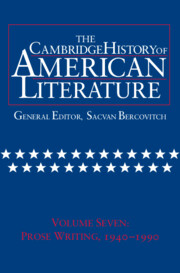Book contents
- Frontmatter
- Introduction
- The Drama, 1940—1990
- Fiction and Society, 1940–1970
- After the Southern Renascence
- 1 Introduction
- 2 Robert Penn Warren
- 3 Carson McCullers
- 4 Flannery O’Connor
- 5 Eudora Welty
- 6 Novels of Race and Class
- 7 Novels of Slavery and Reconstruction
- 8 Walker Percy
- 9 Reynolds Price
- 10 Peter Taylor
- Postmodern Fictions, 1960–1990
- Emergent Literatures
- Appendix: Biographies
- Chronology, 1940–1990
- Bibliography
- Index
6 - Novels of Race and Class
from After the Southern Renascence
Published online by Cambridge University Press: 28 March 2008
- Frontmatter
- Introduction
- The Drama, 1940—1990
- Fiction and Society, 1940–1970
- After the Southern Renascence
- 1 Introduction
- 2 Robert Penn Warren
- 3 Carson McCullers
- 4 Flannery O’Connor
- 5 Eudora Welty
- 6 Novels of Race and Class
- 7 Novels of Slavery and Reconstruction
- 8 Walker Percy
- 9 Reynolds Price
- 10 Peter Taylor
- Postmodern Fictions, 1960–1990
- Emergent Literatures
- Appendix: Biographies
- Chronology, 1940–1990
- Bibliography
- Index
Summary
Both Intruder in the Dust (1948) and To Kill a Mockingbird (1960) set out to be stories about race and turn into stories about class. Because To Kill a Mockingbird is in some ways a stripped-down revision of Intruder in the Dust, it shows its hand more starkly and thus makes a clearer statement about the price of its central strategies. Written with the Emmett Till case in mind and with the Scottsboro Boys case in the background, To Kill a Mockingbird turns on the unsuccessful attempt of a widowed, slightly eccentric, morally decent small-town lawyer, Atticus Finch, to defend a young African American man, Tom Robinson, who has been falsely accused of rape in the south Alabama town of Maycomb during the Depression.
To Kill a Mockingbird is narrated by Atticus’s daughter Scout, a shrewd, vital, feisty, tomboy rather on the model of Mick Kelly in The Heart Is a Lonely Hunter. The naiveté and sensitivity of the narrator serves a political purpose, because there is no better way to make clear the irrationality of racism than to attempt to make sense of it to someone like Scout. Scout herself has to learn to make her way in a very flawed and dangerous world, and her own developing insight and courage are meant to model a younger generation that may repair some of the problems of the world they inherit.
- Type
- Chapter
- Information
- The Cambridge History of American Literature , pp. 367 - 374Publisher: Cambridge University PressPrint publication year: 1999



